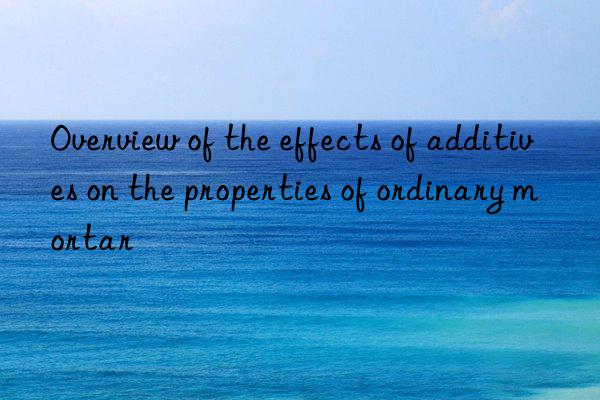
Ordinary mortar mainly includes masonry mortar, plastering mortar and ground mortar, which has the characteristics of large dosage and low cost. Traditional ordinary mortar is generally a mixture of cement, sand and water. With the advancement of technology and the continuous improvement of the performance requirements of ordinary mortar, additives have increasingly become an indispensable component of ordinary mortar. This article briefly introduces the relationship between three commonly used additives in ordinary mortar - cellulose ether, starch ether, air-entraining agent and mortar performance.
1. Cellulose ether
The improvement of water retention and thickening properties helps to improve the mixing and workability of ordinary mortar. In the past, ordinary mortar often achieved this by adding thickening powder. performance. Thickened powder mainly uses non-lime inorganic materials such as bentonite or organic materials such as polyacrylamide as carriers. It is easy to control the proportion of ingredients and is cheap. However, the thickened powder products currently on the market vary from type to quality, and the overall performance Lack of stability often leaves manufacturing companies at a loss as to what to do. Cellulose ethers, which were previously mostly used in special mortars, have now attracted the attention of ordinary mortar manufacturers.
Cellulose ether is the product of etherification reaction of cellulose. In terms of chemical composition, the most commonly used mortar is hydroxypropyl methylcellulose ether (HPMC). First of all, the oxygen atoms of the hydroxyl and ether bonds in the cellulose ether molecules are easily associated with water molecules through hydrogen bonds, "locking" free water into bound water, thus preserving part of the water, delaying the evaporation of water, and increasing the consistency of the slurry. . Secondly, the cellulose ether molecular chains are entangled with each other to form a three-dimensional network structure, which also contributes to the viscosity of the slurry. Thirdly, in wet mortar, cellulose ether gel is distributed in the gaps of cement mortar, playing the role of flexible filling and flexible reinforcement, which can improve the flexibility of mortar. Finally, in the hardened slurry, cellulose ether will form a polymer film with a sealing effect, which can improve the "surface drying" phenomenon of the mortar. At the same time, the water-retaining effect of cellulose ether ensures sufficient hydration of the cement, allowing the mortar to fully develop its later strength.
Compared with thickening powder, the water retention and thickening effect of cellulose ether is more significant and stable, and the dosage is lower. On the premise that the mixing equipment meets the requirements, the comprehensive cost of cellulose ether and thickening The powder is almost the same.
2. Starch ether
Starch ether is the product of starch etherification. The main component of starch raw materials used to produce starch ethers is amylopectin, and its molecular structure is dendritic. Starch ether disperses in the mortar, absorbs water, swells and interacts with various particles in it. It acts as a transitional "bridge" to form a weak network structure, thereby giving the slurry a certain yield value and playing a role in anti-sag or anti-slip.
On the other hand, the combined use of starch ether and cellulose ether can help improve the thickening effect of cellulose ether to a certain extent, extend the opening time, and overcome the viscosity of the slurry when cellulose ether is used alone. The shortcomings of large knife or pumping resistance are significantly improved in construction and pumping properties.
3. Air-entraining agent
When ordinary mortar is mixed with water, a certain amount of air will often be introduced. After the mortar is hardened, its air content is generally related to various factors such as the type and amount of cement, the particle size and gradation of sand, the type and amount of active fillers, the ambient temperature, and the use of additives. Among them, additives that can introduce a large number of evenly distributed, stable and closed tiny bubbles to improve the performance of the mortar are called air-entraining agents.
Within a suitable range, a certain air content is helpful to improve the performance of ordinary mortar. First, in wet mortar, bubbles change the sliding friction between sand particles into rolling friction, which greatly reduces the resistance and thus improves the workability of the slurry. Second, a large number of tiny bubbles weaken the segregation and settlement of wet mortar particles, making the slurry uniform and stable and difficult to stratify. Third, in dry mortar, the air bubble micropore space can alleviate the volume expansion caused by the freezing of residual water and improve the anti-freeze durability of the mortar.
When used together with cellulose ethers, if they are rosin thermopolymers and triterpene saponin air-entraining agents, their air-entraining effect may be inhibited, while alkyl sulfates or composite air-entraining agents Aerosols generally do not have such problems.
</p



 微信扫一扫打赏
微信扫一扫打赏
